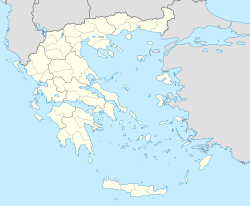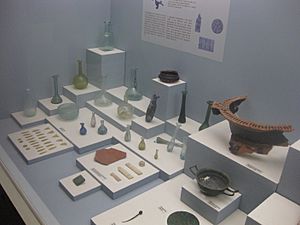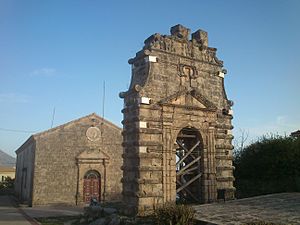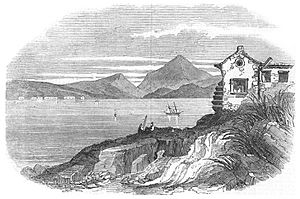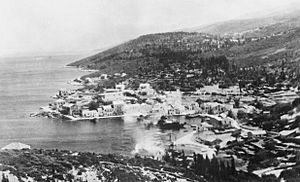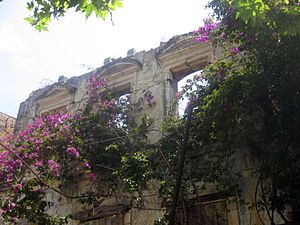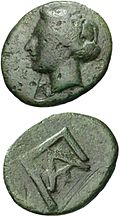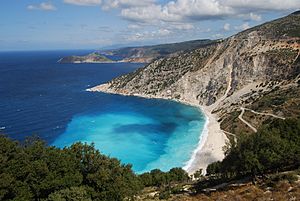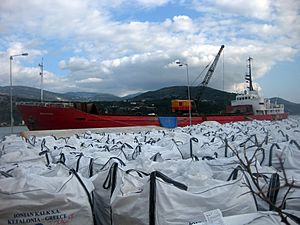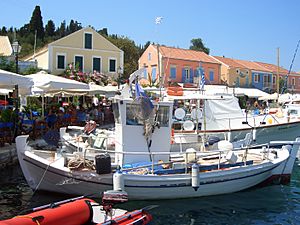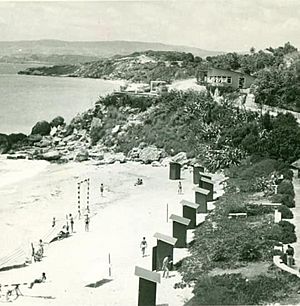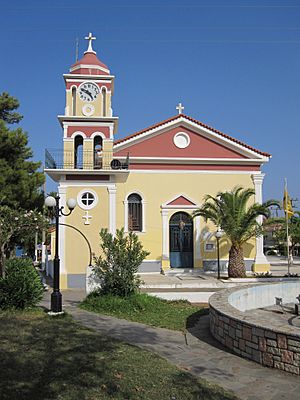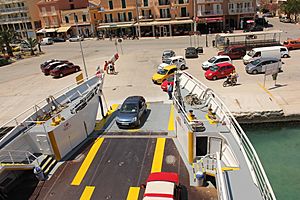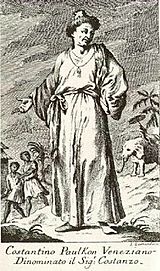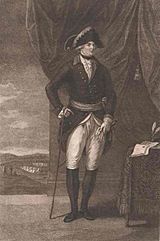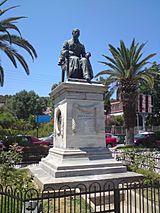Kefalonia facts for kids
Quick facts for kids
Kefalonia
Κεφαλονιά/Κεφαλλονιά
Kefaloniá/Kefalloniá |
|
|---|---|
|
regional unit
|
|
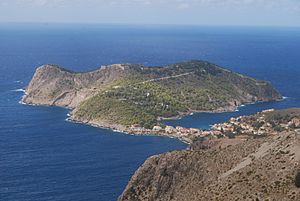
View of Asos, Kefalonia
|
|
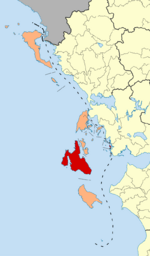
Kefalonia within the Ionian Islands
|
|
| Country | Greece |
| Region | Ionian Islands |
| Capital | Argostoli |
| Area | |
| • Total | 786.58 km2 (303.70 sq mi) |
| • Land | 773 km2 (298 sq mi) |
| Total area includes other islands which form part of the Cephalonia regional unit | |
| Elevation
Mount Ainos
|
1,628 m (5,341 ft) |
| Population
(2011)
|
|
| • Total | 35,801 |
| • Density | 45.5148/km2 (117.8827/sq mi) |
| Time zone | UTC+2 (EET) |
| • Summer (DST) | UTC+3 (EEST) |
| Postal codes |
280 xx
|
| Area codes | 267x0 |
| Car plates | ΚΕ |
Kefalonia (also spelled Cephalonia) is the largest of the Ionian Islands in western Greece. It's the 6th biggest island in Greece overall. Kefalonia is also its own special area, called a regional unit, within the Ionian Islands region. The main city and capital of Kefalonia is Argostoli.
Contents
Discovering Kefalonia's Past
Ancient Times: Myths and Cities
Legends of Kefalonia's Name
One old story says Kefalonia got its name from a hero named Cephalus. He helped a king from Mycenae in a war. As a reward, he received the island of Same, which then became known as Cephallenia.
Some people even think Kefalonia might be the famous Homeric Ithaca, the home of Odysseus. This is instead of the smaller island that has that name today. A project looked into this idea, suggesting that Paliki, now part of Kefalonia, was a separate island long ago.
Early Cities and Greek Wars
From about 600 BC, four main cities ruled the island: Pale (now Lixouri), Krane (now Argostoli), Same (now Sami), and Pronnoi. Each city made its own coins and built impressive temples.
Kefalonia's cities played a role in wider Greek events. For example, 200 soldiers from Pale fought against the Persians at the Battle of Plataea. All four cities also sided with Athens during the Peloponnesian War. The island was important because it was near the entrance to the Bay of Corinth.
Roman Rule and Decline
After the Peloponnesian War, Kefalonia's cities stayed close to Athens. Later, they sent troops to help Alexander the Great conquer the Persian Empire.
Eventually, the Romans invaded and took over Same after a long fight in 189 BC. After this, Kefalonia became less important. The Roman period saw fancy villas built on the coasts, but the old towns became quieter.
Middle Ages: Byzantine and Venetian Control
In the later Roman Empire, Kefalonia was part of a Roman province. It became a very important base for the Byzantine Empire because of its location. It helped stop raids and was a bridge for trips to Italy.
Around the 8th century, Kefalonia became the center of a special military area called a "theme." The capital moved to the Castle of Saint George, which was safer.
In 1185, the island was captured by the Normans. It then became part of a special county under the Kingdom of Sicily. Later, the Ottoman Empire took control in 1479.
Venetian and French Influence
Turkish rule didn't last long. In 1500, a Spanish-Venetian army captured Kefalonia. From then on, Kefalonia was part of the Venetian Republic until it ended in 1797.
During Venetian rule, the island became a major exporter of currants. It also had a large shipping fleet. In 1596, the Venetians built the Assos Castle, which is a popular tourist spot today.
In 1797, France took over Venice, and Kefalonia became part of a French area. But in 1798, a Russian and Turkish fleet forced the French out. From 1799 to 1807, Kefalonia was part of the Septinsular Republic, protected by Russia.
British Rule and Union with Greece
In 1807, the Ionian Islands were given back to France. But in 1809, the British took control. They made the Ionian Islands a British protectorate in 1815.
During this time, Colonel Charles Philippe de Bosset oversaw many public works, including the De Bosset Bridge in Argostoli.
However, Greek people on the island wanted to join Greece. By 1848, there were calls for "enosis" (union) with Greece. Rebellions against British rule happened in Argostoli and Lixouri. Finally, in 1864, Kefalonia and the other Ionian Islands officially became part of Greece.
World War II and Aftermath

During World War II, Kefalonia was occupied by Axis forces. First, it was mainly Italian soldiers, but about 2,000 German troops were also there. When Italy made peace with the Allies in September 1943, confusion broke out.
The Italian soldiers wanted to go home, but the Germans didn't want them to use their weapons against them. The Italians decided to fight the new German invasion. After fierce fighting, the Germans took control of the island. Sadly, thousands of Italian soldiers were killed by the German forces.
After the war, Greece faced a civil war, which ended in 1949.
The Great Earthquake of 1953
Kefalonia is located in an earthquake zone. In August 1953, a series of four powerful earthquakes hit the island. The strongest one, on August 12, destroyed almost every house. Only Fiskardo in the north remained mostly untouched.
The earthquake was so strong that it lifted the entire island about 60 centimeters higher! This disaster caused huge damage. Many people left the island soon after to find new lives elsewhere.
Recent Events
In the 1990s, a large forest fire damaged many forests on the island. Smaller earthquakes have also caused minor damage in recent years.
In 2011, the eight smaller towns on the island joined to form one united municipality. Then, in 2019, it was divided into three municipalities: Argostoli, Lixouri, and Sami. In January 2014, another earthquake caused some injuries and property damage.
Exploring Kefalonia's Archaeology
Kefalonia is a very interesting place for archaeology. Finds on the island go back 40,000 years! The most important period for the island was the Mycenaean era (around 1500 BC to 1100 BC). The Archaeological Museum of Argostoli has important items from this time.
In 1991, archaeologists found a huge Mycenaean Tholos tomb near Poros. This tomb was built around 1300 BC for kings and important officials. It's the largest tomb of its kind found in northwestern Greece. Its size suggests there was a major Mycenaean town nearby.
In 2006, a Roman grave complex was found in Fiskardo. It contained five burial sites, including a large tomb with gold jewelry, glass pots, and bronze items. The tomb was untouched for thousands of years. A well-preserved Roman theatre was also found nearby.
Kefalonia's Population Over Time
In ancient times, people lived in four cities on the island. These cities formed a group called "tetrapolis."
More recently, the population reached 70,000 in 1896. However, it slowly decreased in the 20th century. The big 1953 Ionian earthquake caused many people to leave the island. Many moved to other parts of Greece or emigrated to America and Australia.
Today, the population is around 35,000 to 42,000. In the 2011 census, it was 35,801. Most people from Kefalonia have surnames ending in "-atos," and many villages have names ending in "-ata."
| Year | Population |
|---|---|
| 1879 | 68,321 |
| 1896 | 70,077 |
| 1920 | 55,030 |
| 1940 | 58,437 |
| 1961 | 39,793 |
| 1981 | 41,319 |
| 2001 | 34,544 |
| 2011 | 35,801 |
Geography of Kefalonia
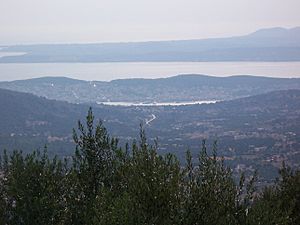
Kefalonia is about 773 square kilometers (300 square miles) in size. The town of Argostoli is home to one-third of the island's people. Lixouri is the second largest town.
The island is in an earthquake zone, so many small tremors happen each year. The 1953 earthquake destroyed most towns, but Fiskardo in the north was spared.
Important natural spots include Melissani Lake, the Drogarati caves, and the Koutavos Lagoon in Argostoli. The island has many unique and rare plants and animals. Some areas are protected as part of the European Union's Natura 2000 network.
Mountains and Capes
The highest mountain on the island is Mount Ainos, which is 1628 meters (5,341 feet) tall. The top of Mount Ainos is covered with fir trees and is a natural park.
Forestry is not common, but Kefalonia produces more timber than other Ionian islands. Forest fires are a big threat, especially in hot, dry summers.
Some important capes (points of land sticking into the sea) are Cape Agios Georgios, Cape Kounopetra, and Cape Atheras.
Flora and Fauna of Kefalonia
Plant Life
Most of the Ainos mountain range is a National Park. It's home to rare Greek fir trees and black pine trees.
Animal Life
Kefalonia is known for its endangered loggerhead sea turtle population, also called Caretta caretta turtles. They lay their eggs on many beaches along the south coast. You can also see these turtles in the waters of Argostoli harbor.
A small number of the endangered Mediterranean monk seal also live around the island's coast. They use caves to give birth and raise their pups. One famous breeding spot is a cave on Foki beach near Fiskardo.
The European pine marten also lives on the island. Over 200 types of birds have been seen here.
Kefalonia's Climate
Kefalonia has hot, sunny summers and mild, rainy winters. It has a hot-summer Mediterranean climate. Sometimes, it snows on the mountain peaks in winter.
Winter months can have a lot of rain, making the island humid. Winter temperatures are usually around 14-15°C (57-59°F) during the day. Summers are usually dry with temperatures around 30°C (86°F) during the day.
| Climate data for Argostoli (1981–2010) | |||||||||||||
|---|---|---|---|---|---|---|---|---|---|---|---|---|---|
| Month | Jan | Feb | Mar | Apr | May | Jun | Jul | Aug | Sep | Oct | Nov | Dec | Year |
| Mean daily maximum °C (°F) | 14.3 (57.7) |
14.1 (57.4) |
15.7 (60.3) |
18.5 (65.3) |
22.9 (73.2) |
27.0 (80.6) |
29.5 (85.1) |
29.9 (85.8) |
26.9 (80.4) |
23.5 (74.3) |
19.0 (66.2) |
15.5 (59.9) |
21.5 (70.7) |
| Daily mean °C (°F) | 11.3 (52.3) |
11.1 (52.0) |
12.3 (54.1) |
14.9 (58.8) |
19.7 (67.5) |
22.6 (72.7) |
25.1 (77.2) |
25.7 (78.3) |
23.0 (73.4) |
19.9 (67.8) |
15.9 (60.6) |
12.6 (54.7) |
17.8 (64.0) |
| Mean daily minimum °C (°F) | 8.3 (46.9) |
8.0 (46.4) |
9.0 (48.2) |
11.2 (52.2) |
14.5 (58.1) |
18.2 (64.8) |
20.6 (69.1) |
21.6 (70.9) |
19.1 (66.4) |
16.3 (61.3) |
12.8 (55.0) |
9.7 (49.5) |
14.2 (57.6) |
| Average rainfall mm (inches) | 93.1 (3.67) |
100.0 (3.94) |
66.6 (2.62) |
49.7 (1.96) |
20.4 (0.80) |
10.5 (0.41) |
1.3 (0.05) |
5.6 (0.22) |
31.3 (1.23) |
94.7 (3.73) |
155.9 (6.14) |
150.0 (5.91) |
779.1 (30.68) |
| Average rainy days (≥ 1.0 mm) | 9 | 9 | 9 | 5 | 3 | 1 | 0 | 1 | 3 | 7 | 11 | 12 | 70 |
| Source: Meteo-climat-bzh | |||||||||||||
Kefalonia's Economy
In the past, Wine and raisins were the main products exported from Kefalonia. Today, fish farming and calcium carbonate are very important. Many Greek ship-owning families originally came from islands like Kefalonia.
Farming and Olive Oil
The main farming activities are raising animals and growing olives. Most of the island is rugged and mountainous, good for goats. Less than a quarter of the land can be used for crops.
Until the 1970s, most people lived in the countryside. Now, two-thirds live in towns. The island has a long history of winemaking, especially known for its dry, white wines made from the Robola grape.
Making olive oil is a big part of Kefalonia's economy. There are over one million olive trees on the island, covering about 55% of its area. Kefalonian olive oil has a green color and a rich taste.
Tourism on the Island
Tourism to Kefalonia started in the early 1800s. The Greek royal family even sent their children to Lixouri in the early 1900s. But the island became popular with most tourists in the 1980s. Many Italians visit because it's close to Italy.
Popular places to visit include the fishing villages of Fiscardo and Assos. Natural attractions like Melissani underground lake, Drogarati cave, and Myrtos beach also draw visitors. The movie Captain Corelli's Mandolin (film) (2001), filmed on the island, made Kefalonia even more famous.
Culture and Traditions
Monasteries and Churches
Kefalonia has two large monasteries. One is Haghia Panagia in Markopoulo. The other is the monastery of Saint Gerasimus of Kefalonia, the island's patron saint. You can see his holy items at the old church there.
Many churches on the island survived the earthquakes, some dating back to the Renaissance. Their decorations show Venetian art styles.
Music and Arts
The Ionian Islands have a special music tradition called the Ionian School. Lixouri has a Philharmonic Orchestra that started in 1836. This music style was influenced by Italian music and Western harmonies.
The "Cantada" (Serenade) is a unique musical style from the Ionian Islands. These songs are still very popular today.
Literature and Film
The novel Captain Corelli's Mandolin by Louis de Bernières is set on Kefalonia. The story takes place during World War II, around the time of the Massacre of the Acqui Division. A film based on the book was released in 2001.
Museums to Visit
- Korgialeneios Museum in Argostoli
- Kosmetatos Foundation in Argostoli
- Archaeological Museum of Argostoli
- Iakovatios-Library (and museum) in Lixouri
- Museum in Fiskardo
- Kefalonia Natural History Museum
- Nautical Museum of Sami
Education and Sports
Higher Education
- Ionian University, Argostoli Campus (Departments of Food Science and Technology, and Digital Media and Communication)
- Ionian University, Lixouri Campus (Department of Ethnomusicology)
- National Merchant Marine Academy, Argostoli
- The Music School of Kefalonia – Rokos Vergotis Conservatory, Argostoli
Sports Clubs
Baseball
- AINOS Kefalonia
Cycling
- AINOS Kefalonia podilatikos omilos
Football (Soccer)
|
|
|
|
Other Sports
- Nautical Racing Club of Kefalonia and Ithaca
- Natura & Pet – Veterinary pharmacy
Getting Around Kefalonia
Harbors and Ports
You can reach Kefalonia by boat. There are four main harbors:
- Sami: A major port with ferries to Patras and Ithaca.
- Poros: In the south, with ferry routes to Kyllini.
- Argostoli: The largest port, for local boats and ferries to Zante and Lixouri.
- Fiscardo: In the north, with links to Lefkas and Ithaca.
Lixouri is across the bay from Argostoli. A ferry goes between them every hour, or every half-hour in peak season.
Roads and Public Transport
The first larger roads were built by the British in the 1800s. Today, almost all roads connecting villages and beaches are paved.
There are some bus lines for rural areas, but they run less often. The KTEL bus cooperation offers services from Lixouri, Poros, and Argostoli to the mainland.
Kefalonia's Airport
Kefalonia has one airport, Kefalonia Island International Airport, named Anna Pollatou. It's about 10 kilometers (6 miles) south of Argostoli. Most scheduled flights are with Olympic Air to and from Athens. In summer, many charter flights from Europe also arrive.
Since 2016, a company called Fraport AG/Copelouzos Group manages Kefalonia Airport and 13 other regional airports in Greece.
How Kefalonia is Governed
Kefalonia is a special regional unit within the Ionian Islands region. Since 2019, it has three municipalities: Argostoli, Lixouri, and Sami. Before 2019, there was just one municipality for the whole island. The main town and seat of government is Argostoli.
The municipality of Argostoli includes:
- Argostoli
- Eleios-Pronnoi
- Leivatho
- Omala
The municipality of Sami includes:
- Erisos
- Pylaros
- Sami
The municipality of Lixouri is the same as the former municipality of Paliki.
The Kefalonia regional unit also includes some uninhabited islands from the Echinades group.
Famous People from Kefalonia
Many notable people have come from Kefalonia:
- Cephalus: A hero from Greek mythology, believed to be the ancestor of all Kefalonians.
- Odysseus: The famous king of Ithaca from Homer's epic poems.
- Juan de Fuca (Ioannis Phokas) (1536–1602): A captain and explorer.
- Constantine Phaulkon (1647–1688): An adventurer who became a chief advisor to the King of Ayutthaya.
- Giacomo Pylarini (1659–1718): A doctor who helped develop early smallpox inoculation.
- Ilias Miniatis (1669–1714): A clergyman, writer, and preacher born in Lixouri.
- Andreas Metaxas (1786–1860): A former prime minister of Greece.
- Panayis Athanase Vagliano (1814–1902): A merchant and shipowner, known as the father of modern Greek shipping.
- Ioannis Metaxas (1871–1941): A general and prime minister of Greece.
- Spyridon Marinatos (1901–1974): A famous archaeologist.
- Richard Wright (1943–2008): Keyboard player for the band Pink Floyd, who lived on the island.
- Anna Pollatou (1983–2014): A rhythmic gymnast who won a bronze medal at the 2000 Summer Olympics.
Images for kids
See also
 In Spanish: Cefalonia para niños
In Spanish: Cefalonia para niños
- Sacred snakes of Cephalonia


